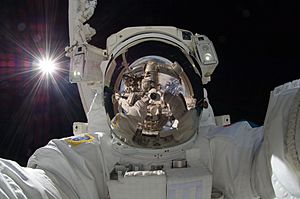Akihiko Hoshide facts for kids
Quick facts for kids
Akihiko Hoshide
|
|
|---|---|

Hoshide in a spacesuit in 2012
|
|
| Born | December 28, 1968 Setagaya, Tokyo, Japan
|
| Status | Active |
| Nationality | Japanese |
| Alma mater | Keio University University of Houston |
| Occupation | Engineer |
| Space career | |
| NASDA/JAXA astronaut | |
|
Time in space
|
340 days 11 hours 41 minutes |
| Selection | 1999 NASDA Group |
|
Total EVAs
|
4 |
|
Total EVA time
|
28 hours and 17 minutes |
| Missions | STS-124, Soyuz TMA-05M (Expedition 32/33), SpaceX Crew-2 (Expedition 65/66) |
|
Mission insignia
|
     |
Akihiko Hoshide (星出 彰彦, Hoshide Akihiko, born December 28, 1968) is a Japanese engineer and JAXA astronaut. He even commanded the International Space Station! On August 30, 2012, Hoshide made history by becoming the third Japanese astronaut to walk in space.
Contents
Becoming an Astronaut: Early Life and Education
Akihiko Hoshide was born in Tokyo, Japan, on December 28, 1968.
He studied at the United World College of South East Asia in Singapore. In 1992, he earned a bachelor's degree in mechanical engineering from Keio University. Later, in 1997, he received a master's degree in aerospace engineering from the University of Houston.
Working Towards Space: Early Career
In 1992, Hoshide joined the National Space Development Agency of Japan (NASDA). He worked on developing the H-II rocket for two years. From 1994 to 1999, he helped prepare astronauts for their missions. He even supported astronaut Koichi Wakata during his training for the STS-72 mission.
Astronaut Training and Missions

In February 1999, NASDA (now JAXA) chose Hoshide as one of three Japanese astronaut candidates. They were training for the International Space Station (ISS). He started his basic astronaut training in April 1999 and became a certified astronaut in January 2001.
Since 2001, he has continued advanced training for the ISS. He also helped develop the equipment and operations for the Japanese Experiment Module, called Kibō. He also worked on the H-II Transfer Vehicle (HTV), which is a cargo spacecraft.
Underwater and Underground Training
From July 21 to July 29, 2014, Hoshide commanded NASA Extreme Environment Mission Operations Mission 18 (NEEMO 18). This mission took place at the Aquarius Reef Base off the coast of Key Largo, Florida. He lived underwater with other astronauts to practice for space missions.
In 2016, he joined the European Space Agency's Cooperative Adventure for Valuing and Exercising human behaviour and performance Skills (CAVES) expedition. He spent two weeks living in caves underground. This helped simulate what it's like to be in space.
First Mission: STS-124
Hoshide's first space mission was STS-124 aboard the Space Shuttle Discovery. This mission was important because it delivered a big part of the Japanese Experiment Module, Kibō, to the ISS. STS-124 launched on May 31, 2008.
Discovery docked with the International Space Station on June 2, 2008. The crew spent eight days installing the Kibō module. Hoshide and another astronaut used a robotic arm to move the module from Discovery to its new spot on the ISS. The next day, the crews opened Kibō for the very first time!
Hoshide and the STS-124 crew stayed on the ISS until June 11, 2008. Discovery then undocked and returned to Earth. On June 14, 2008, Discovery landed safely. The mission lasted 13 days, 18 hours, and 13 minutes.
Second Mission: Expedition 32/33
In November 2009, Hoshide was chosen for Expedition 32/Expedition 33 as a flight engineer. He trained in Russia and was a backup crew member for an earlier mission.
Hoshide, along with Russian cosmonaut Yuri Malenchenko and NASA astronaut Sunita Williams, launched aboard Soyuz TMA-05M on July 15, 2012. After a two-day journey, they arrived at the ISS on July 17, 2012. They joined the Expedition 32 crew already on board.
On August 27, 2012, Hoshide used a robotic arm to capture and attach JAXA's HTV-3 cargo spacecraft. On August 30, he went on his first spacewalk with Sunita Williams. This spacewalk lasted over eight hours! They prepared equipment for future repairs. On September 5, they went on another spacewalk to replace a camera and other parts.
On September 16, 2012, some crew members left the station. Hoshide, Williams, and Malenchenko then became part of the Expedition 33 crew. Williams took command of the station. They were later joined by new crew members. On October 11, 2012, Hoshide and Williams successfully captured SpaceX's Cargo Dragon spacecraft. This was the first time a private cargo ship delivered supplies to the ISS.
On November 1, Hoshide went on a third spacewalk with Williams. This spacewalk lasted six hours and 38 minutes. During this spacewalk, Hoshide set a new record for the most total spacewalk time for a Japanese astronaut, with over 21 hours!
Expedition 33 ended on November 18, 2012. Hoshide, Malenchenko, and Williams landed safely in Kazakhstan after 127 days in space.
Third Mission: Expedition 65/66
Hoshide launched into space for the third time in 2021 aboard SpaceX Crew-2. He served as a flight engineer on Expedition 65. On April 27, 2021, Hoshide took command of the ISS from NASA astronaut Shannon Walker. He became only the second Japanese astronaut to command the station.
See also
 In Spanish: Akihiko Hoshide para niños
In Spanish: Akihiko Hoshide para niños

